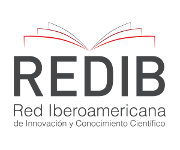Polymerisation by acrylamide and acrylic acid inverse suspension
El proceso de polimerización por suspensión inversa del ácido acrílico y acrilamida
DOI:
https://doi.org/10.15446/ing.investig.v25n1.14628Keywords:
inverse suspension polymerisation, acrylamidde, acrylic acid, polymerisation, hydrogel synthesis kinetics (en)polimerización por suspensión inversa, acrilamida, ácido acrílico, polimerización, cinética de sintesis del hidrogel (es)
Downloads
This work describes polymerization by inverse suspension of acrylamide monomers and acrylic acid for forming homopolymers or copolymers. This type of polymerization’s advantages are described and reasons given for why it should be studied. The article stresses the importance of these types of monomer for obtaining materials presenting great affinity for water, such as super-absorbents and controlled liberation mechanisms. Important aspects are presented such as type of initiation, monomer composition and continuous phase composition; parameters are described offering an important basis for formulating a system leading to successfully obtaining the desired materials. The final part (relying on data found in the literature) describes dependence on some of the synthesized materials’ most relevant characteristics such as particle distribution and size, polymerization kinetics, conversion and water absorption capacity respecting the system’s modifiable parameters. The foregoing is important since the product can be modified, bestowing properties on it which are suitable for its use.
Este trabajo describe el proceso de polimerización por suspensión inversa de los monómeros acrilamida y ácido acrílico para la formación de homopolímeros o copolímeros. Se describen las ventajas de este tipo de polimerización y por qué es importante su estudio. Se recalca la importancia de este tipo de monómeros para la obtención de materiales que presentan gran afinidad por el agua como los superabsorbentes y los dispositivos de liberación controlada; se presentan aspectos importantes como el tipo de iniciación, la composición de la fase de monómeros y composición de la fase continua, describiendo parámetros que ofrecen una base importante para la formulación del sistema que conllevan a la obtención exitosa de los materiales deseados.
En la parte final, por medio de datos hallados en la literatura, se describe la dependencia de algunas de las características más relevantes de los materiales sintetizados, como la distribución y tamaño de partícula, cinética de polimerización, conversión, y la capacidad de absorción de agua con respecto a parámetros modificables del sistema. Lo anterior es importante ya que así se puede modificar el producto confiriéndole propiedades adecuadas para su utilización.
References
Rodriguez, F., Principles of Polymer Systems. TMH Edition, Tata McGraw Hill Publishing Company, New Delhi, pp. 105-112, 1974.
Renard, B. & McKenna, T., “Kinetics of polymerization of partially neutralized acrylic acid in inverse suspensions.” Macromolecular Symposia, Vol. 150,1974. pp. 251-257, 2000. DOI: https://doi.org/10.1002/1521-3900(200002)150:1<251::AID-MASY251>3.0.CO;2-H
Holmberg, K. et al. Surfactants and Polymers in Aqueous Solutions. 2nd Edition, Jonh Wiley & Sons Ltd, England, pp. 451-452, 2003.
Lin, Hong-Ru., “Solution polymerization of acrylamide using potassium persulfate as an initiator: kinetics studies, temperature and pH dependence”, European Polymer Journal, Vol. 37, pp. 1507-1510, 2001. DOI: https://doi.org/10.1016/S0014-3057(00)00261-5
Peppas, N. A. et al., “Hydrogels in pharmaceutical applications”, Journal of Pharmaceuticals and Biopharmaceuticals, Vol. 50, pp. 27, 2000. DOI: https://doi.org/10.1016/S0939-6411(00)00090-4
Omidian, H. et al., “Modified acrylic-based superabsorbent polymers (effect of temperature and initiator concentration)”, Polymer, Vol. 39, pp. 3.459-3.465, 1998. DOI: https://doi.org/10.1016/S0032-3861(97)10236-1
Dimonie, M. et al. “The topochemistry of acrylamide polymerization in inverse suspension”, Journal of Macromolecular Science. Pure and Applied Chemistry, Vol. A29, No. 3, pp. 277-296, 1992. DOI: https://doi.org/10.1080/00222339208052126
Kumar, A. & Gupta, R. Fundamentals of Polymers. International Editions, McGraw-Hill International Editions, Singapore, pp. 142-145, 1998.
Katime, I., Química física macromolecular. primera edición, Servicio Editorial Universidad del País Vasco, Bilbao, 1994.
Liu, Z. & Brooks, B., “A study of inverse dispersion polymerization of acrylic acid using water — soluble redox initiators”, Journal of Applied Polymer Science, Vol. 66, pp. 2.191-2.199, 1997. DOI: https://doi.org/10.1002/(SICI)1097-4628(19971219)66:11<2191::AID-APP15>3.0.CO;2-4
Liu, Z. & Brooks, B., “Kinetics of redox polymerizations of acrylic acid in inverse dispersion and in aqueous solution” Journal of Polymer Science: Part A. Polymer Chemistry, Vol. 37, pp. 313-324, 1999. DOI: https://doi.org/10.1002/(SICI)1099-0518(19990201)37:3<313::AID-POLA8>3.0.CO;2-Z
Kiatkamjornwong, S. & Punchareon, P, “Influence of reaction parameters on water absorption of neutralized poly(acrylic acid-co-acrylamide) synthesized by inverse suspension polymerization.” Journal of Applied Polymer Science, Vol. 72, pp. 1.349-1.366, 1999. DOI: https://doi.org/10.1002/(SICI)1097-4628(19990606)72:10<1349::AID-APP16>3.0.CO;2-K
Omidian, H. et al. “Modified acrylic-based superabsorbent polymers (dependence on particle size and salinity)” Polymer, Vol. 40, pp. 1.753-1.761, 1999. DOI: https://doi.org/10.1016/S0032-3861(98)00394-2
Perry, R., “Datos fisico-químicos”, Manual del Ingeniero Químico, 6ta Edición, Vol. 1, McGraw-Hill, México, Tomo I. pp. 230-250, 1992.
Arshady, R., “Suspension, emulsion and dispersion polymerization: A methodological survey”, Colloid & Polymer Science, Vol. 270, pp. 717-732, 1992. DOI: https://doi.org/10.1007/BF00776142
Wang, G. Li, M. & Chen, X., “Inverse suspension polymerization of sodium acrylate.” Journal of Applied Polymer Science, Vol. 65. 1997 pp. 789-794. DOI: https://doi.org/10.1002/(SICI)1097-4628(19970725)65:4<789::AID-APP16>3.0.CO;2-O
Mayoux, C. et al., “Inverse suspension polymerization of sodium acrylate: synthesis and characterization.” Journal of Applied Polymer Science, Vol. 77, pp. 2621-2630, 2000. DOI: https://doi.org/10.1002/1097-4628(20000919)77:12<2621::AID-APP90>3.0.CO;2-X
Tsung Chen, H. & Middleman, S., “Relationships for mean particle diameter in dispersions of two immiscible liquids”, AIChE Journal, Vol. 13, pp. 989-996, 1967. DOI: https://doi.org/10.1002/aic.690130529
Flory, P.J., Principles of Polymer Chemistry, primera Edición, Coronell University Press, Ithaca, New York, 1953.
Obayashi, et al. “Alkali metal acrylate or ammonium acrylate polymer excellent in salt solution-absorbency and process for producing same”, United States, Patent No. 4,340,706. Julio 20 1982.
Lloreda S. “Hidrogeles de base acrílica sintetizados mediante polimerización por suspensión inversa. Estudio experimental y caracterización termodinámica” tesis presentada a la Universidad Nacional de Colombia para optar al grado de magister en ingeniería química, 2004.
Askari, et al. “Synthesis and characterization of acrylic based superabsorbents”, Journal of Applied Polymer Science, Vol. 50., pp. 1851, 1993. DOI: https://doi.org/10.1002/app.1993.070501022
Okay, O. & Sariisik, S. “Swelling behavior of poly(acrylamide-co-sodium acrylate) hydrogels in aqueous salt solutions: theory versus experiments”, European Polymer Journal, Vol. 36, pp. 393, 2000. DOI: https://doi.org/10.1016/S0014-3057(99)00058-0
Martínez, G.; Sánchez-Chaves, M. & Madruga, E., “Preparación y aplicaciones de poliácidos acrílicos y poliacrilamidas” Revista de Plásticos Modernos, Vol. 77, pp. 281, 1999.
Achilleos, E.; Christodoulou, K. & Kevrekidis, Y., “A transport model for swelling of polyelectrolyte gels in simple and complex geometries.” Computational and Theoretical Polymer Science, Vol. 11, pp. 63, 2001. DOI: https://doi.org/10.1016/S1089-3156(99)00060-4
Levenspiel, O., Chemical Reaction Engineering, Third Edition, John Wiley & Sons Inc., United States of America, 1999.
Lloreda, S., “Síntesis de hidrogeles de base acrílica por suspensión inversa”, Memorias del II Congreso Internacional de Materiales, VII Congreso Nacional de Corrosión y Protección, Bucaramanga, Universidad Industrial de Santander, 2003.
How to Cite
APA
ACM
ACS
ABNT
Chicago
Harvard
IEEE
MLA
Turabian
Vancouver
Download Citation
License
Copyright (c) 2005 Sergio Alejandro LLoreda Blanco

This work is licensed under a Creative Commons Attribution 4.0 International License.
The authors or holders of the copyright for each article hereby confer exclusive, limited and free authorization on the Universidad Nacional de Colombia's journal Ingeniería e Investigación concerning the aforementioned article which, once it has been evaluated and approved, will be submitted for publication, in line with the following items:
1. The version which has been corrected according to the evaluators' suggestions will be remitted and it will be made clear whether the aforementioned article is an unedited document regarding which the rights to be authorized are held and total responsibility will be assumed by the authors for the content of the work being submitted to Ingeniería e Investigación, the Universidad Nacional de Colombia and third-parties;
2. The authorization conferred on the journal will come into force from the date on which it is included in the respective volume and issue of Ingeniería e Investigación in the Open Journal Systems and on the journal's main page (https://revistas.unal.edu.co/index.php/ingeinv), as well as in different databases and indices in which the publication is indexed;
3. The authors authorize the Universidad Nacional de Colombia's journal Ingeniería e Investigación to publish the document in whatever required format (printed, digital, electronic or whatsoever known or yet to be discovered form) and authorize Ingeniería e Investigación to include the work in any indices and/or search engines deemed necessary for promoting its diffusion;
4. The authors accept that such authorization is given free of charge and they, therefore, waive any right to receive remuneration from the publication, distribution, public communication and any use whatsoever referred to in the terms of this authorization.



























